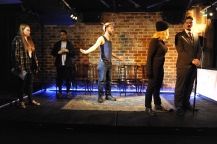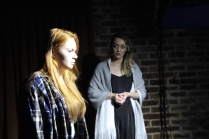
Meg Hyeronimus
Danen Young: How does it feel to play such an iconic figure as Marilyn?
Meg Hyeronimus: Initially, terrifying. I didn’t really know much about her other than the typical “blonde bombshell” character and that she’s the most famous blonde of all time or at least the 20th Century. So yeah, completely overwhelmed. I dove into my research, gathered everything I could find and found her to be so incredibly extraordinary and complex. As Arthur Miller said in an interview “whatever anybody was she had a little of it”. I also quickly accepted that I’d never be Marilyn. That took some stress away. I think the script definitely helps with that – with the breaking down of her public persona, and portrays a more real and human version of her. My relationship to her has become incredibly personal, I find myself fighting for her in whatever way possible – in everyday life or during rehearsal (I suppose that’s a real driving force for me in the show) and I love her a lot. I feel her pain and her hope. It’s also opened a lot up for me as an actor, I feel more confident in myself and owning my power. I’m very grateful for the whole process.
How is it different this time round?
I think there is an obvious shift in each of us, it feels like we’ve matured as actors/theatre-makers. Don’t get me wrong, we very much are still those excited passionate kids – but the approach to our work is more direct and fast paced. The vision for what we want is clearer; for Alec (playing Arthur) and I as actors making choices for our characters and for Danen and his directorial vision. There is a lot more freedom for me as Marilyn now. I’m not trying as hard to be a certain way. I think I have a better understanding of her, or rather MY Marilyn and all that character stuff (which the first time round plagued me for a while). It now comes second nature, leaving me with so much more room to PLAY! It’s so FUN, even when it tears my heart apart.
What is your favourite thing about the rehearsal room?
Well, that I get to work with two of my best friends. Also the silly characters that are always floating around. Alec has one whose name is Timothy Panknell. He’s from somewhere in Brooklyn. And never ever fails to make me laugh. Danen and Alec both take on who they think Arthur Miller’s mother would sound and be like. It’s probably the funniest thing I’ve witnessed first hand.
We have so many stupid jokes and outbursts of nonsense, and it’s generally Alec saying something so absurd and ridiculous that Danen and I lose it for a good 5 mins.
It’s a good base for us to be open and just play around with the script, despite the work being so sincere and somewhat philosophical.
If you could have dinner with any famous person from the past, who would it be?
Is it annoying to say Marilyn, because honestly that would be my first choice. I’m desperate to speak to her. Other than that, Hatshepsut. She’s one boss ass bish!
Marilyn’s from LA and Arthur’s from New York, so where would you rather live, LA or New York?
Young Meg would say New York in a heartbeat. And I would say present Meg would say it too, just a little more hesitant. I need space and love nature, so I’ll say LA. That is my final answer. Which is lucky considering I’m moving there in 3 weeks, HA!

Danen Young
Meg Hyeronimus: LA or NY?
Danen Young: Oooooh that’s tough. I’d have to say NYC in terms of a city to live in. There is sooooooooo much happening in such a small amount of area, and it literally never sleeps. Which is absolutely perfect for a night owl like myself!!
Dinner guest?
I would have to say Nikola Tesla. Such an incredible mind that was not as successful and far reaching as he should have been. The memory of his great work was stomped on by Thomas Edison and I would just want to say sorry for that!!
How different has it been directing this time around?
There have actually been a lot of things that are similar about directing this time around. The difference mainly being the length, and the challenges we’ve faced in terms of developing a rhythm for the show. The short and sweet version of the play was probably a bit nailed into us, so breaking free of this emotional and muscle memory was the first big hurdle. In terms of staging, lighting, and sound the show is coming together fairly in the same, but on a larger scale; so the lighting plots are more complex, there are more sound cues, and more blocking to figure out. But being on a small budget, and having restrictions on how much set we can have, means that we’ve kept the set minimal, to focus on the characters, relationships and memories that Jasper has so beautifully written into his script. Rehearsals are still super fun and full of cheeky banter!
Why produce this play?
Firstly, because the script is amazing. For actors, the words just pull you along, and it’s a beautiful thing to watch. But I think it’s also a very interesting take on memory, and celebrity culture in this highly connected world of social media. How can we really know who these people were? Whose word can you trust as an authority on what these people were like? Does it really matter? Is it possible to know someone if you’ve never met them? I can’t really answer these questions, but I want to say that the overwhelming feeling I’ve had whilst directing this play, is that our memories are who we are, but in the end, it’s the memory of us in the minds of other people that define who we are.
Describe the show in 3 words.
Sincere. Ethereal. Heartbreaking.
Meg Hyeronimus plays Marilyn Monroe, and Danen Young directs Arthur & Marilyn, by Jasper Lee-Lindsay.
Dates: 29 May – 2 Jun, 2018
Venue: Blood Moon Theatre
 Venue: Blood Moon Theatre (Potts Point NSW), Oct 11 – 19, 2017
Venue: Blood Moon Theatre (Potts Point NSW), Oct 11 – 19, 2017

























 Venue: Blood Moon Theatre (Potts Point NSW), Sep 25 – 29, 2018
Venue: Blood Moon Theatre (Potts Point NSW), Sep 25 – 29, 2018 Venue: Blood Moon Theatre (Potts Point NSW), Sep 4 – 8, 2018
Venue: Blood Moon Theatre (Potts Point NSW), Sep 4 – 8, 2018






 Venue: Blood Moon Theatre (Potts Point NSW), Aug 22 – 30, 2018
Venue: Blood Moon Theatre (Potts Point NSW), Aug 22 – 30, 2018 Venue: Blood Moon Theatre (Potts Point NSW), Jun 13 – 16, 2018
Venue: Blood Moon Theatre (Potts Point NSW), Jun 13 – 16, 2018 Venue: Blood Moon Theatre (Potts Point NSW), May 29 – Jun 2, 2018
Venue: Blood Moon Theatre (Potts Point NSW), May 29 – Jun 2, 2018

